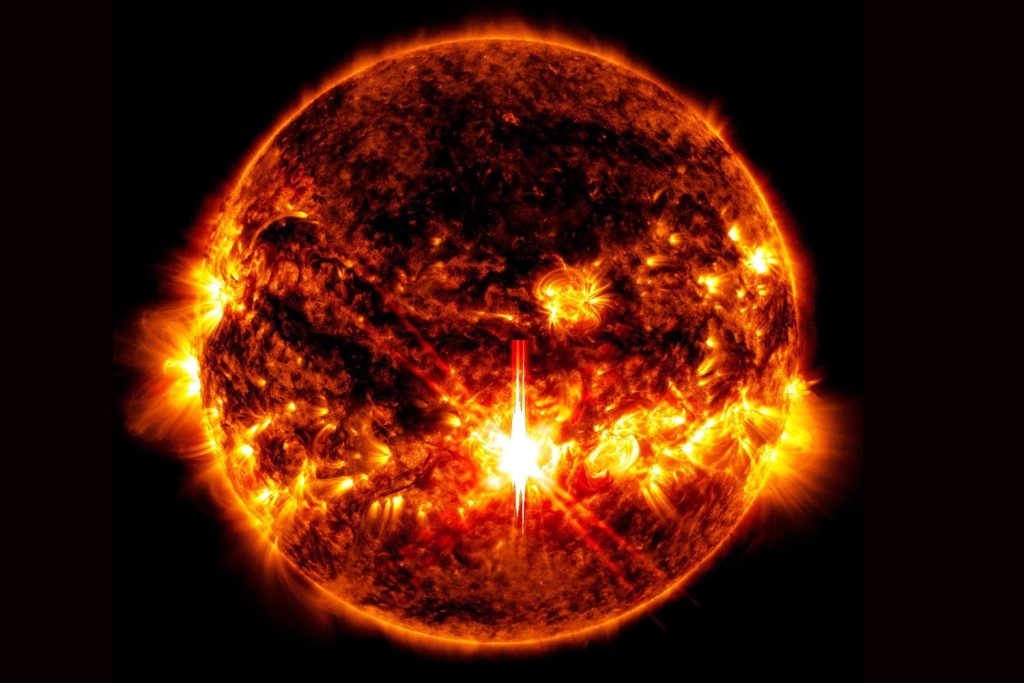
How the Impending Major Geomagnetic Storm Will Impact Earth—and Where to See Auroras (Image Credit: Gizmodo-com)
The third geomagnetic storm in five months is heading towards Earth and will arrive at our hardy little planet either today or tomorrow, according to the National Oceanic and Atmospheric Administration’s Space Weather Prediction Center. The storm follows an x-class solar flare and coronal mass ejection which occurred on the Sun’s surface on Tuesday. Here’s what you need to know about the upcoming storm.
What is a geomagnetic storm?
A geomagnetic storm is a space weather phenomenon caused by explosions on the Sun’s surface. There are two different solar events that come into play here: solar flares and coronal mass ejections. As outlined by EarthSky, solar flares are brilliant flashes of light induced by magnetic activity on the Sun’s surface, like the criss-crossing of magnetic fields. Coronal mass ejections are eruptions of solar material that are ejected from the Sun, which can cause geomagnetic disturbances on Earth if the events are directed towards our planet. Those geomagnetic disturbances range from beautiful aurora in our planet’s skies to disruptions in the electrical grid and other human infrastructure.
As the Sun approaches the maximum of its 11-year solar cycle, the space weather tends to get more intense. In May, Earth was hit by the strongest geomagnetic storm in 20 years, causing aurora to be seen from the planet’s northern reaches to as far south as Florida and Texas. That event was a G4 storm, and prompted the first geomagnetic storm watch alert since January 2005; the coming storm will not exceed a strength of G3, according to the Space Weather Prediction Center.
Solar flares are scored on their intensity, from b-class to x-class, with each letter class representing a tenfold increase in intensity. The flare on Tuesday had a rating of X7.1. This morning, NASA’s Solar Dynamics Observatory observed an X9.0 solar flare which peaked at 8:18 a.m. ET.
Is there reason for alarm?
Not really. The storm is expected to be anywhere between a G1 event (a minor storm which would arrive today) or a G3 event (a stronger storm which would arrive tomorrow). If you use high-frequency communication bands or talk over the radio you could experience disruptions anywhere between a few minutes to a couple of hours, according to a NOAA alert.
In the alert, NOAA warned of “limited, minor effects to some technological infrastructure.” However, the potential effects of the strong flare this morning included “immediate, wider area of strong degradation of signal loss in high frequency (HF) communication bands over much of the sunlit side of Earth.” So again, if you rely on radio communication you will likely see some disruptions.
As Gizmodo reported in anticipation of the May storm (which again, was much stronger than whatever kind of event arrives on Earth in the next 24 hours), there’s not much one can do to prepare for a geomagnetic storm “outside of what you would normally do to prepare for a power outage.”
So as you would for any emergency, make sure you have the basic standards in emergency equipment, like a flashlight, batteries, or even a backup generator. But that’s general advice: the coming storm should only have a noticeable effect on high-frequency communication, in the range of 3 to 30 megahertz. It’s not going to knock out your power.
Where and when will the geomagnetic storm cause auroras?
Auroras are forecast across most of Alaska and Canada, according to the Space Weather Prediction Center’s experimental Aurora Dashboard. The center also forecast a low likelihood for auroras in some of the northern reaches of the continental United States, including in Washington, Idaho, Montana, North Dakota, Minnesota, and Wisconsin. Auroras may also be visible in northern Russia and Antarctica.

But if you’re farther south than that, don’t despair. Brent Gordon, chief of the Space Weather Services Branch at the Space Weather Prediction Center, told Gizmodo in May that: “With new technology in our phones, we’ve been seeing some amazing aurora shots even further south.”
“Even things the human eye can’t see, your phone can,” Gordon added, so it may be worth shooting a picture of the sky and seeing what your camera picks up.
Will there be more geomagnetic storms soon?
The Sun is generally a hospitable host, but it has its temper tantrums. Even since I began writing this article, the Sun had another—even more intense—solar flare. That X9.0 flare was stronger than the X7.1 event on Tuesday.
Shawn Dahl, a service coordinator for the Space Weather Prediction Center, told Gizmodo in August that storms caused by coronal mass ejections can be fairly hard to predict; often, scientists can only characterize the effects of the space weather on Earth when the storms are between 15 to 45 minutes from arriving. “Bottom line is, we’re going to be under the influence of increased activity all of this year, all of next year, and even in 2026 where we’ll continue to have higher chances this type of activity to continue to happen from time to time over the remainder of this solar cycle maximum that we’re experiencing,” Dahl said.
Suffice to stay, the Sun is a predictable star—but still has tricks up its celestial sleeve. You can expect more geomagnetic storms as the Sun goes through its solar cycle, but experts won’t know when and how those events will impact Earth until days, or even minutes, before the events come to pass.
With rare exception—such as the 1859 Carrington Event—the events won’t have an outsize impact on your daily life, unless you have a fleet of satellites under your command. Here’s hoping we all catch a glimpse of some auroras!





